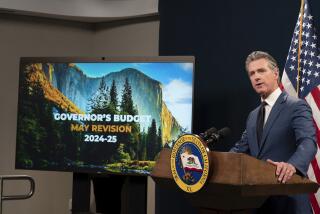Interest Rate War Brewing With Billions in CD Funds Maturing
- Share via
California savers finally are getting relatively good deals on certificates of deposit from the state’s biggest savings institutions.
And rates offered by many institutions throughout the nation are expected to improve in the next few weeks, as banks and savings and loans slug it out to capture billions of dollars in CDs maturing in October.
With sick savings and loans under pressure to lower their rates, the largest California banks and savings and loans are becoming more competitive. They are now offering on average among the highest yields on six-month and one-year CDs among big institutions nationwide, according to a survey to be released Monday by 100 Highest Yields, a North Palm Beach, Fla., newsletter that tracks CD rates.
The average annual yield on six-month CDs offered by the 10 largest banks and thrifts in Los Angeles and San Francisco totaled 8.46% and 8.49%, respectively, 100 Highest Yields said. Those exceeded average yields for each of the eight other largest metropolitan areas tracked by the newsletter. They also exceeded the average yield--8.28%--for the 100 largest banks in the 10 largest metropolitan areas nationwide, the newsletter said.
That reverses the trend of most of the past decade, when the state’s major institutions offered among the nation’s lowest yields, presumably because they were unwilling to compete aggressively. Six months ago, for example, the top 10 Los Angeles institutions were paying 0.29 percentage points below the national average.
“This should be a welcome piece of news to the average California consumer who, compared with the rest of the nation, has been underpaid by his or her local bank during most of the past six years and nine months of deregulation,” said Robert K. Heady, editor of 100 Highest Yields. In the past, he added, “California consumers have pretty much gotten the shaft from the state’s largest banks.”
Norberto Mehl, chairman of Banxquote Money Markets, a New York service that tracks CD rates, also noted that the five highest yields in one-month and two-month CDs in his survey were offered by California institutions, albeit smaller ones.
Two Active Periods
“There seems to be a rate war in the state, primarily in the retail sector,” Mehl said.
While other experts were hesitant to label recent developments a rate war, they said one could develop this month as institutions battle to capture more than $100 billion of CD money that will mature in October. Average rates nationwide may rise as much as half a percentage point because of the competition for maturing CD dollars, predicted Martin G. Bradshaw, publisher of RateGram, a San Rafael, Calif., newsletter that tracks high-yielding accounts.
October and April are the largest months for CD maturities, because many investors opened up six-month or one-year CDs in October, 1987, following the stock market crash. Billions also flowed into CDs in October, 1983, when the federal government fully deregulated rates on short-term CDs.
To be sure, rates in California have become more attractive relative to others nationwide not because they have risen in recent weeks, but rather because they have fallen less. Rates nationwide have fallen as banks’ prime lending rates, Treasury bill rates and other rates in the economy have slipped amid slowing economic growth.
Rates also are beginning to fall because of the federal government’s takeover of ailing thrifts. A handful of thrifts taken over by the government already have lowered their deposit rates, prompting depositors to search elsewhere for homes for their money.
Already some California institutions are beginning to boost advertisements and promotional gimmicks. Valley Federal Savings, for example, is running ads offering camcorders and other gifts to depositors opening new CDs. A spokeswoman said the S&L; is trying to keep current Valley Federal depositors from taking their money elsewhere.
Some Don’t Plan to Join
However, some institutions said they don’t foresee participating in any heated rate wars to capture money from failed thrifts or maturing CDs.
Phil Altman, senior vice president for West Coast branch administration at Great Western Bank, said his institution’s cash needs are not as great these days because loan demand has flattened. Also, the S&L; is raising more money through the secondary mortgage market.
“We’re going to stay competitive, but we’re not going to be the high price leader and never have been,” Altman said.
More to Read
Inside the business of entertainment
The Wide Shot brings you news, analysis and insights on everything from streaming wars to production — and what it all means for the future.
You may occasionally receive promotional content from the Los Angeles Times.










